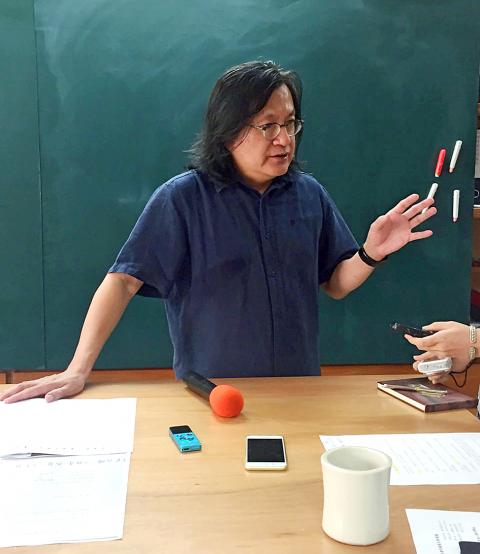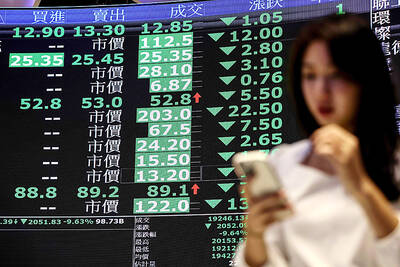The Taipei City Government yesterday said it had reported Farglory Group (遠雄集團) and two architects overseeing the construction of the Taipei Dome to its disciplinary committees, and that it had upheld a punishment imposed on Farglory in May to halt the construction of the arena after the city government’s appeal review committee last month rejected an appeal by the group.
Taipei Department of Urban Development Commissioner Lin Jou-min (林洲民) made the announcements prior to a protest by a group of employees of companies involved in the Dome’s construction, who said the city government’s ordering the project to be halted infringed on their right to work.
Citing Article 18 of the Architects Act (建築師法), Lin said that the department had reported the architect overseeing the construction, Stan Lo (羅興華), and his predecessor, Hsu Shao-yu (徐少游), to the city’s Disciplinary Committee for Architects over professional negligence in overseeing the construction.

Photo: CNA
Meanwhile, Farglory and project co-contractor Obayashi Corp had been reported to the city’s Construction Enterprise Review Committee over their failure to carry out work according to the construction plan, alleged breaches of Article 26 and Article 35 of the Construction Industry Act (營造業法), Lin said.
Lin said the two architects could face punishments ranging from a warning, demerits or having their licence suspended for between two months and two years, to their licenses being revoked or invalidated.
Possible punishments that the construction companies and their specialists face include a warning and a suspension of their operations for between three months and one year, he said.
However, depending on the committees’ conclusions, the individuals and firms might not be punished, he added.
He said that although previous structural concerns surrounding the Dome, including the stability of its foundations and a purported “upward buoyancy force” caused by the suspended construction are under control, the project must meet four requirements before construction can be resumed.
First and foremost, it must pass a review administered by the Taiwan Architecture and Building Center, which would assess whether the project complies with a set of provisions, Lin said.
Then, it would have to pass an environmental impact assessment, an urban design review and, finally, a review of its construction licenses, he added.
Asked to comment on the protesters, Lin said that while the Taipei City Government is concerned about them, agreements between their companies and Farglory was not a matter the city government can intervene in.
Meanwhile, Taipei Mayor Ko Wen-je (柯文哲) called on Farglory to take a proactive stance on resolving public safety issues concerning the Taipei Dome, rather than threatening to file lawsuits.
Ko said that compared with safety concerns, he is less worried about the nominal royalties to be paid by Farglory should the Dome become operational, adding: “What good does money do if people are dead?”
Under a contract inked between then-Taipei mayor Ma Ying-jeou (馬英九) and Farglory, royalty payments required from the firm were set at zero to 1 percent of the arena’s annual revenues, which sparked controversy over Ma’s administration improperly benefiting the corporation, which was selected by the city government in 2004 to undertake the build-operate-transfer project.

ACTION PLAN: Taiwan would expand procurement from the US and encourage more companies to invest in the US to deepen bilateral cooperation, Lai said The government would not impose reciprocal tariffs in retaliation against US levies, President William Lai (賴清德) said yesterday, as he announced five strategies to address the issue, including pledging to increase Taiwanese companies’ investments in the US. Lai has in the past few days met with administrative and national security officials, as well as representatives from various industries, to explore countermeasures after US President Donald Trump on Wednesday last week announced a 32 percent duty on Taiwanese imports. In a video released yesterday evening, Lai said that Taiwan would not retaliate against the US with higher tariffs and Taiwanese companies’ commitments to

‘SPECIAL CHANNEL’: Taipei’s most important tasks are to stabilize industries affected by Trump’s trade tariffs and keep negotiations with Washington open, a source said National Security Council Secretary-General Joseph Wu (吳釗燮) arrived in the US for talks with US President Donald Trump’s administration, a source familiar with the matter said on Friday. Wu was leading a delegation for a meeting known as the “special channel,” the Financial Times reported earlier. It marked Trump’s first use of the channel since returning to the White House on Jan. 20. Citing a source familiar with the matter, the Financial Times reported that Minister of Foreign Affairs Lin Chia-lung (林佳龍) was also a part of the delegation. The visit came days after China concluded war games around Taiwan and amid Trump’s

Intelligence agents have recorded 510,000 instances of “controversial information” being spread online by the Chinese Communist Party (CCP) so far this year, the National Security Bureau (NSB) said in a report yesterday, as it warned of artificial intelligence (AI) being employed to generate destabilizing misinformation. The bureau submitted a written report to the Legislative Yuan in preparation for National Security Bureau Director-General Tsai Ming-yen’s (蔡明彥) appearance before the Foreign Affairs and National Defense Committee today. The CCP has been using cognitive warfare to divide Taiwanese society by commenting on controversial issues such as Taiwan Semiconductor Manufacturing Co’s (TSMC, 台積電) investments in the

HELPING HAND: The steering committee of the National Stabilization Fund is expected to hold a meeting to discuss how and when to utilize the fund to help buffer the sell-off The TAIEX plunged 2,065.87 points, or 9.7 percent, to close at 19,232.35 yesterday, the highest single-day percentage loss on record, as investors braced for US President Donald Trump’s tariffs after an extended holiday weekend. Amid the pessimistic atmosphere, 945 listed companies led by large-cap stocks — including Taiwan Semiconductor Manufacturing Co (TSMC, 台積電), Hon Hai Precision Industry Co (鴻海精密) and Largan Precision Co (大立光) — fell by the daily maximum of 10 percent at the close, Taiwan Stock Exchange data showed. The number of listed companies ending limit-down set a new record, the exchange said. The TAIEX plunged by daily maxiumu in just